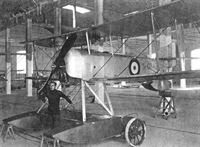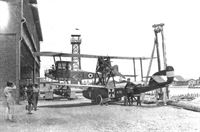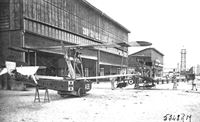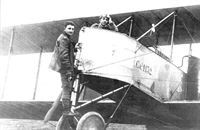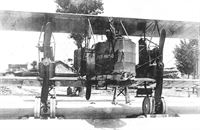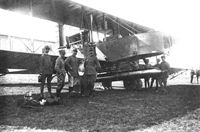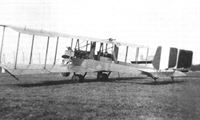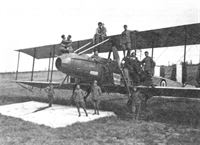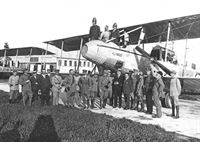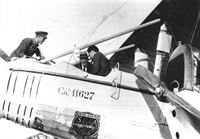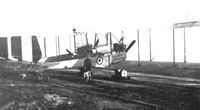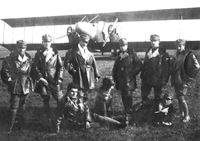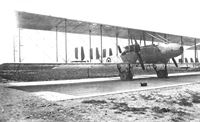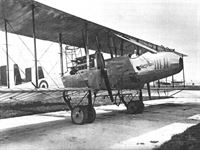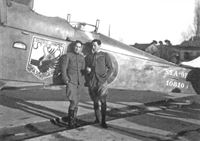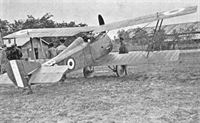Книги
Aeronaut
R.Gentilli
Italian Aviation Units in the First World War. Vol.4
351
R.Gentilli - Italian Aviation Units in the First World War. Vol.4 /Aeronaut/ (4)
Lohner L127 as it appears in the recently renovated Historical Museum of the Italian Air Force at Vigna di Valle, near Rome.
On 3 June 1918 two sailors of Italian ethnicity deserted from the small base of Lussino arriving to Fano with Lohner L127, which was then taken to Ancona, here it is seen with TV Briganti. L127 is now exhibited in the Italian Air Force Museum at Vigna di Valle.
Airco de Havilland DH.4 of the Royal Air Force, behind them an SP.3 and a Nieuport 11 of the Sezione Difesa Grottaglie appear.
A Short 320 of the Royal Naval Air Service; these floatplanes were active in the Lower Adriatic Sea.
Sopwith Baby 6849 of the 255a Squadriglia at Brindisi. It was possibly of French construction. (Archive Caliaro)
An Ansaldo SVA, possibly 11720 of Natale Palli, with some Sopwith Camels of the Royal Air Force in an unidentified airfield of Southern Italy.
The wreck of Brandenburg CC A15 of Frglt. Soupper who crashed on 11 February 1917 after having killed the commander of the Venice Station, TV Garrassini.
K308 was later brought to Brindisi. As can be seen, this class of single engine flying boat was quite large.
The captured Austrian fighter A91 in Venice; behind it there is an M.5 of the 260a Squadriglia, probably serialled 7289, showing the letters "Ja" that surely stood for Guido Jannello.
Ansaldo Balilla 16609 at San Nicolo; behind it a Nieuport 10.
Ansaldo A.1 Ballila #16609 was a late-war Italian fighter design. Fast but not very maneuverable, It was introduced into service late in the war and only scored one confirmed victory during WWI. It went on to a lengthy postwar career.
Ansaldo A.1 Ballila #16609 was a late-war Italian fighter design. Fast but not very maneuverable, It was introduced into service late in the war and only scored one confirmed victory during WWI. It went on to a lengthy postwar career.
TV Luigi Bologna, the leading Italian naval aviator of the Great War, with a Balilla of the 241a Squadriglia. On his breast there are the ribbons of six medals, a high number, considering the strict criteria of that time.
Tomaso Cartosio in Fiume, in front of a SVA of the 87a Squadriglia. Four pilots of this unit deserted and joined d'Annunzio: Censi, Granzarolo, Locatelli, and Sarti.
An Ansaldo SVA, possibly 11720 of Natale Palli, with some Sopwith Camels of the Royal Air Force in an unidentified airfield of Southern Italy.
SVA 14742 flew with the 242a Squadriglia. After the war, fitted with an Isotta Fraschini engine, it served at the Breda flying school at Sesto S. Giovanni.
Tomaso Cartosio gained fame for reaching d'Annunzio at Fiume tied over the top wing of SVA 18858 with pilot serg. Giulio Bellaria.
A Caproni Ca.5 and an SVA at Brindisi. The Caproni shows an American roundel, possibly being one of the Ca.5s that American pilots flew to Apulia in July 1918 for missions across the Adriatic that were not flown for technical problems of the airplane.
ISVA 15265 of the 258a Squadriglia. All seaplane stations received som examples of the floatplane version of the SVA, but none knew what to do with them.
Alberto Barberis, second from the right, was a pilot with the 161a Squadriglia. Here he is shown in 1919 with the American dancer Ida Rubinstein, with the SVA used for their flight over the Alps.
Cap. Augusto Gauthier was commander of the 117a Squadriglia in 1918. Here he is post-war in the cockpit of a SVA.
Some sort of ceremony at San Nicolo; this is the only known photo of the SVAs of the Squadra San Marco.
The Bossi bomber was built at the Fratelli Zari plant. It was beautiful but it crashed during tests.
A few Bresciani bombers were built, and series production began, but the whole program was scrapped.
Old Caproni 300 hp 1132 served in 1916 with the 1a Squadriglia, then the 74a, and was still in service at Centocelle, Rome, after the war.
Caproni 1245 served first with the 5a Squadriglia, then with the 202a Sezione at Campiglia Marittima and then with the flying school at Foggia.
A Caproni Ca.3 with the name "Sufficit animus" (courage is enough) fitted with a searchlight and has the front landing gear removed for the tests for the night torpedo attack on Pola.
A crew snapshot next to an unusually shiny bomber.
Ca.3 2334 ready for its mission; the motto on its nose is "Per la Patria" (for the fatherland).
Ca.3 2334 ready for its mission; the motto on its nose is "Per la Patria" (for the fatherland).
Ca.3 4175 of the 201a Squadriglia at Marcon carries the Lion of St. Mark on its nose, behind it a Nieuport 17 of the 80a Squadriglia.
Besides the Lion of St. Mark on the nose, the Capronis of the 201a Squadriglia also carried an anchor on the fuselages.
The first production Caproni triplane, 5347. Caproni chief test pilot Emilio Pensuti is fifth from the left, standing.
A British commission at the Caproni works on October 1917. Behind them, a Ca.4 and the only Ca.53 single engine bomber triplane.
Old Bill, returning from a mission at the end of October 1918, landed at San Nicolo airfield, Venice, drawing a lot of interest.
Ca.4 5374 with its crew, bombed up for a mission. A cover has been added to protect the front gunner.
Ca.4 14664 of the 181a Squadriglia. Behind the serial there is an insignia of the Caproni firm, of which a clear version has not been found yet.
N-528, here still with British airmen, had the cartoon character Old Bill painted on its nose and sides. (Archive Peter Selinger)
The Caproni triplanes for the Royal Navy Air Service were not used, and were turned over to the Italians. N-526 has on its nose a scary face with wings.
Two Caproni triplanes at Poggio Renatico. The one on the left has the number 16 and a chevron on the fuselage, the one on the right a roundel. (Archives Caliaro)
A Ca.4 triplane at Poggio Renatico. A large quantity of steel girders were imported from America to build hangars for a huge fleet of bombers.
At Taliedo, Milan, a Caproni Ca.4 has received new markings for an aviation exhibition in New York City, January 1919.
Caproni Ca.4 triplane bomber with bomb container and "CAPRONI" painted under the bottom wing. This was a Ca.4 that was shipped to New York for an exhibition in early 1919.
Caproni also built a large triplane bomber that was used operationally in small numbers by Italy and Britain. It combined the twin nacelle, tri-motor configuration with a large triplane wing cellule that enabled carrying a heavy bomb load due to the large wing area. The bombs were carried in the streamlined housing below the main nacelle. The extensive struts and bracing created a lot of drag, ensuring it was slow. The triplane configuration made fighters too slow but could enable a lot of wing area for bombers and flying boats with a reasonable wing span.
Caproni Ca.4 triplane bomber with bomb container and "CAPRONI" painted under the bottom wing. This was a Ca.4 that was shipped to New York for an exhibition in early 1919.
Caproni also built a large triplane bomber that was used operationally in small numbers by Italy and Britain. It combined the twin nacelle, tri-motor configuration with a large triplane wing cellule that enabled carrying a heavy bomb load due to the large wing area. The bombs were carried in the streamlined housing below the main nacelle. The extensive struts and bracing created a lot of drag, ensuring it was slow. The triplane configuration made fighters too slow but could enable a lot of wing area for bombers and flying boats with a reasonable wing span.
Ten. Amerigo Contini, a veteran Caproni pilot, was an artist whose paintings and postcards are remarkable for accuracy and realism.
Caproni Ca.5 11648 of the 203a Squadriglia with personnel posing in weird arrangements. (Trovato Finardi via Bussi)
Caproni Ca.5 11627 was the special machine for Gabriele d'Annunzio, carrying his personal insignia, "Semper adamas". Here it is at the Caproni factory with one of the many visiting groups.
A closer look of d'Annunzio's insignia, "Semper adamas", always steel. Under the cockpit there is a scroll with the name "Giuseppe Miraglia". The gentleman in the cockpit with Gianni Caproni is Arthur Duckham, chief of the Advisory Committee of the British Ministry of Ammunitions.
A Caproni Ca.5 and an SVA at Brindisi. The Caproni shows an American roundel, possibly being one of the Ca.5s that American pilots flew to Apulia in July 1918 for missions across the Adriatic that were not flown for technical problems of the airplane.
A late-production Ca.5 of the 204a Squadriglia, with Isotta Fraschini engines, at Brindisi. (Archive Mauro Antonellini)
Caproni Ca.5 11609 ready for delivery to the 1a Squadriglia Navale SA, showing the shackles for the torpedo.
Ca.5 11610; the insignia of the 1a Squadriglia Navale was applied directly at the factory.
Some Ca.5 were also completed as torpedo bombers. Ca.11610, here pictured on Taliedo’s concrete runway, carries the insignia of the Prima Squadriglia Siluranti Aeree (First Airborne Torpedo Squadron) “San Marco”, formed under D’Annunzio’s command at Venice’s San Nicolo airfield in March 1918.
Some Ca.5 were also completed as torpedo bombers. Ca.11610, here pictured on Taliedo’s concrete runway, carries the insignia of the Prima Squadriglia Siluranti Aeree (First Airborne Torpedo Squadron) “San Marco”, formed under D’Annunzio’s command at Venice’s San Nicolo airfield in March 1918.
A British commission at the Caproni works on October 1917. Behind them, a Ca.4 and the only Ca.53 single engine bomber triplane.
A Macchi L.1 being hoisted on RN Europa, where the laundry is hanging out. The serial 113 is clearly visible on the hull, but the rudder carries the serial 124.
Macchi L.1 L148 which crashed on 9 September 1916 killing capo Battista. The letters SV stand for Stazione Varano or San Nicola Varano.
Macchi L.1 L161, armed with a Colt machinegun and a Revelli, ready for the mission of 13 September 1916. In the cockpit Gabriele d'Annunzio and TV Bologna.
Four Macchi L.1s at the mooring place on Gorgo island, Grade. Behind them appears the Fabre Glisseur, a French wingless aircraft that could float at speed. (AUSMM)
Macchi LC 253 at Venice. The Lohner Celere (fast) also called L.2, was an improved version of the L.1, only ten were built.
A Macchi LC showing the insignia of Naval aircraft in 1916, the Italian flag painted on the top wings.
A Macchi L.3 taking off from Sant. Andrea; it carries a pennant and a streaming ribbon, probably to indicate the squadron leader.
A Macchi L.3 from Varano visiting Pescara, where a seaplane station was being built for the US Navy, that was not completed. (Collection Iacomino - Parviero)
Macchi L.3 3404 of the 253a Squadriglia at Grado. The pilot is Guido Jannello. Jannello won the Schneider Trophy race at Bournemouth in 1919 flying a SIAI S.13; of poor health, he died in 1931.
Mario Conforti, with L.3 3415, later was part of the Italian air mission to Argentina in 1919, and then an airline pilot with Aero Espresso.
The growing power of Italian naval aviation in Venice appears in this image of Macchi L.3 of the 252a Squadriglia.
TV Francesco De Pinedo (second from right) posing for an official photograph with CF Salvatore Denti di Pirajno (at his right) and the CO of the 262a Sqa, STV Umberto Maddalena (first from left). The L.3 on the turntable (coded '20'; serial: 7345) is the same aircraft in which De Pinedo flew on the Bocche on 5 and 11 May 1918. Denti di Pirajno at that time held the office of Direttore dei Servizi Aeronautici (Director of the Air Services) at Brindisi. AUSMM.
In front of Macchi L.3 7345 there are Umberto Maddalena, CF Salvatore Denti di Pirajno,TV De Pinedo, Jaccarino.
In front of Macchi L.3 7345 there are Umberto Maddalena, CF Salvatore Denti di Pirajno,TV De Pinedo, Jaccarino.
All the airmen appearing in front of this Macchi L.3 are identified with their names. (Archive Longhi)
A Macchi L.3 of the 259a Squadriglia. The insignia is not historically correct: when Venice was at war, the Lion of St. Mark was holding a sword, but the book was closed.
Domenico Arcidiacono with his Macchi L.3 showing his motto,"I casi sono due", there are two cases, from a vaudeville act of 1917 by Ettore Petrolini.
TV Federico Martinengo with an L.3 of the 253a Squadriglia. He died in September 1943, now an Admiral, fighting against the Germans after Italy's surrender, and was posthumously awarded the Gold Medal for Bravery; a frigate of the Italian Navy is now named after him.
Casagrande and his L.3 with the motto, in Neapolitan dialect, "Comme Vene Vene", it goes as it goes.
Vittorio Manzoni sitting next to the Isotta Fraschini engine of an L.3, he died in a crash on 13 June 1917. (Archive De Antoni)
Details of the cockpit of an L.1; the amount of material that went into its construction is impressive.
A Macchi L.3 at Brindisi; on its side the weight to pull down the aerial for the W/T transmitter can be seen.
Macchi M.5 M.7293, Ens. W.B. Haviland, USN, Porto Corsini NAS, Summer 1918
Macchi M.5 flown by Ensign Willis Haviland, commander of the USN flying unit at Porto Corsini.
Macchi M.5 flown by Ensign Willis Haviland, commander of the USN flying unit at Porto Corsini.
The first Macchi M.M. (M standing for monoposto, single-seater) were assigned to the 251a Squadriglia in the summer of 1917.
Orazio Pierozzi in the cockpit of Macchi M.5 7087; behind there are two battleships of the "Vittorio Emanuele II" class.
TV Bologna's Macchi M5 7101 with his insignia of a cat's head and the red and green stripes on the hull that were the 260a Squadriglia markings.
The Macchi M.5 7262 of Luigi De Riseis with his insignia of a smiling Buddha. The 261a Squadriglia marked its fighters with a serrated white motif.
The Macchi M.5 of TV Bortolozzo shows a skull and the Latin motto "Frangar, non fleeter" (I break, but I don't bend). The same motto was probably written on the right side. The serial was 7288. (Archive Caliaro)
The captured Austrian fighter A91 in Venice; behind it there is an M.5 of the 260a Squadriglia, probably serialled 7289, showing the letters "Ja" that surely stood for Guido Jannello.
Young STV Calvello also had a Happy Hooligan as his insignia, the cartoon says "Ocio ocio fiol d'un can" (watch out, son of a dog). The serial number could be either 7283 or 7289.
Capo Pagliacci, landing in Trieste harbor on 2 November 1918 in Macchi M.5 13057, was the fist Italian to reach that city.
Aimone di Savoia did not fly with the 261a Squadriglia, but he received a personal Macchi M.5, with serial 13080. (Archive Caliaro)
One of the colorful Macchi M.5 fighters based at Porto Corsini flown by the US Navy.
American naval seaplanes in Italy carried gaudy color schemes, like this Macchi M.5 13089.
American naval seaplanes in Italy carried gaudy color schemes, like this Macchi M.5 13089.
Domenico Arcidiacono sitting in his Macchi M.5 with a cartoon character and his motto"I casisono due".
Another Macchi M.5 "I casi sono due" with dragon livery of TV Arcidiacono. All modern renderings of this livery show the basic color as yellow, but this is to be doubted, as orthochromatic film would have made yellow look much darker.
A Macchi M.5 of the 262a Squadriglia; on the roundel there is the Latin motto "Nec sine gloria cadet", it falls with glory.
The Macchi M.5 of TV Pierozzi featuring the head of a dog that holds an Austrian seaplane in its mouth.
An M.5 targeted in the gunsight of a photo camera gun during the frequent training flights of the fighters of the Stazione Miraglia.
Macchi M.5 with an Austro-Hungarian battleship in the background. As far as is known, no such scene actually occurred, but we plead artistic license; when the artist presented this it was too exciting not to use.
The Macchi M.7 of Renato Spada after the end of the war. The words "Cum'am guod!.." in the dialect of Romagna mean: Am I enjoying it! (Courtesy Il Fronte del Cielo)
On the pier of Brindisi, four Macchi M.5 mod. of the 262a Squadriglia; this version was indistinguishable from the M.7.
Macchi M.8 7373 was assigned to the 251a Squadriglia in April 1918. Its serial is not part of an M.8 production lot, and was assigned also to an L.3 of the 253a Squadriglia.
Macchi M.8 13588 of the 251a Squadriglia in Fiume, autumn 1919, during the occupation by the volunteers of Gabriele d'Annunzio. (Archive Antonellini)
The same M.8 parked in the hangar of Trieste, on its left side is written "Non toccare", do not touch, on the right side it carried "Pericolo di morte".
Side View if a Pomilio PC P 3757 Tractor Biplane for armed reconnaissance from 1917. 260 h.p. Fiat A.12 engine, allowing about 114 m.p.h. Later models became similar but refined PDs and PEs.
Much hope was placed in the Pomilio PC, which the Navy wanted to escort its flying boats over the Adriatic Sea.
Much hope was placed in the Pomilio PC, which the Navy wanted to escort its flying boats over the Adriatic Sea.
The crew of the first combat flight of the 131a Squadriglia, in front of the Pomilio PC, cap. Bourlot and ten. Magistrelli. A Lewis gun is mounted on the top wing.
Serg.m. Pasut and a colleague in front of a PD armed with a Fiat gun for the observer and a Lewis over the top wing.
A Pomilio PD; on the fuselage it is marked 132a Sq., but the officer is ten. Ermenegildo Laghi, who flew with the 134a Squadriglia.
A PD of the 131a Squadriglia at Cascina Farello, from where it flew missions in support of the seaplanes of the Navy. (Photo MAE)
A PD of the 131a Squadriglia getting bombed up for a mission. The airman in dark overalls is t.col. Alberto Novellis di Coarazze, commander of I Gruppo, who flew some combat missions with this unit.
Brig. Pancani was from Florence, and an elaborate version of the shield of that city adorns Pomilio 6923.
Airmen with Pomilio PE 6998 of the 131a Squadriglia. The white dot over the roundel is not a defect of the photo, it is an actual stain on the airplane.
On the fuselage of PE 7025 over the national colors is written "17.4.18 Cpr. Parodi Ten. Borgarello" relative to the feat in which the two airmen saved this airplane, with the pilot badly wounded.
French personnel look at Pomilio PE 7029 of the 139a Squadriglia at San Pietro in Gu airfield, that in early 1918 was base to both Italian and French squadrons.
Pomilio PE 14973 of the 132a Squadriglia is a "doppio commando", the dual controls version used for training.
Primo Alpi, on the left, was a valiant pilot of the 116a Squadriglia, decorated with a Bronze Medal. (Archive Angelo Emiliani)
Leaning on the propeller is brig. Zelindo Pancani, a long-serving reconnaissance pilot, who probably deserved more than the three Bronze Medals that he earned.
Pomilio PE of the 136a Squadriglia at Ponte San Marco; the officer is ten. Giovanni Dandolo, later an engineer with Piaggio and Romeo, who managed the license production of the Fokker C.V in Italy.
A beautiful insignia on a Pomilio PE of the 120a Squadriglia. The observer is ten. Elio Rossi, who died on 29 October 1918. (Archive Toni Tano)
Possibly the same Pomilio as the one above, with a different crew; in both photos some flowers are affixed to the strut in front of the pilot.
A Pomilio PE of the 134a Squadriglia, possibly at Ganfardine. In the background there are SP.3s and a Pomilio PD.
Serg.m. Pasut and s.ten. Nam of the 131a Squadriglia with Pomilio PD 3768. (Archive Fiorenzo Longhi)
The Pomilio PD 3854 of capitani Giorgio Girardet and Pietro Rocca crashed in the Isonzo River on 4 October 1917.
Cap. Ottorino Mutti, here with a SAML of the 118a Squadriglia, was a popular and efficient commander.
Cesare Redaelli in the cockpit of SAML I-BACG of the company SAIAM with his pupil Benito Mussolini, who signed this photo as a "faithful pilot".
SAML 1534 was assigned to the 120a Squadriglia and was lost in an accident on 4 January 1918. Strangely, while belonging to a production lot 1533-1603, of S.1 with 3-bay wings with six struts, it has 2-bay wings with four struts.
SAML 2941 of the 121a Squadriglia, with a visiting British officer in a very elegant uniform. (Collection Carmelo Biz)
SAML 3030 of the 121a Squadriglia; this is the airplane in which ten. Velo was killed, on 7 December 1917. (Collection Carmelo Biz)
The SAML was another of the efficient Italian reconnaissance machines that saw active service in 1917 and 1918.
On these SAMLs of the 118a Squadriglia the serials 3018 and 2536 can be seen.
On these SAMLs of the 118a Squadriglia the serials 3018 and 2536 can be seen.
Air-to-air photographs of Italian airplanes in World War 1 are rare; this is SAML 3008, the observer in the back cockpit is Tomaso Cartosio.
The three main Italian two-seaters, an SP.3 at right, a SIA 7B in the center, and, in the left background, a SAML.
A minor landing accident to SAML 3008, this airplane was put back in service. (Collection Carmelo Biz)
The three main Italian two-seaters, an SP.3 at right, a SIA 7B in the center, and, in the left background, a SAML.
A Pomilio PE of the 134a Squadriglia, possibly at Ganfardine. In the background there are SP.3s and a Pomilio PD.
Airco de Havilland DH.4 of the Royal Air Force, behind them an SP.3 and a Nieuport 11 of the Sezione Difesa Grottaglie appear.
The three main Italian two-seaters, an SP.3 at right, a SIA 7B in the center, and, in the left background, a SAML.
Close-up of SIA 9b serial 10792 of 1a Squadriglia Navale S.A.
The SIA 9B was a big and powerful airplane, this 10792 was not delivered to the Squadra San Marco of d'Annunzio, so it likely was part of the equipment of the 161a Squadriglia.
The SIA 9B was a big and powerful airplane, this 10792 was not delivered to the Squadra San Marco of d'Annunzio, so it likely was part of the equipment of the 161a Squadriglia.
The 1a Squadriglia Navale was regularly using the SIA 9B when it was considered too dangerous and destined to the scrapheap.
SIA 9B at San Nicolo, the airmen are (maybe) Garrone, Thaon di Revel, Barberis, and d'Annunzio, sitting, Pacchiarotti.
This close-up of SIA 9b serial 10796 shows its unit markings for 1a Squadriglia Navale S.A. in more detail. D'Annunzio is the man on the right.
This close-up of SIA 9b serial 10796 shows its unit markings for 1a Squadriglia Navale S.A. in more detail. D'Annunzio is the man on the right.
This close-up of SIA 9b serial 10810 shows its unit markings for 1a Squadriglia Navale S.A.
Ten. Garrone and cap. Macchi with SIA 9B 10810 which they flew on the last bombardment of Pola, 22 October 1918. Near the tail a motto is written, "Tramite recto", the direct way, and an eagle is painted.
Ten. Garrone and cap. Macchi with SIA 9B 10810 which they flew on the last bombardment of Pola, 22 October 1918. Near the tail a motto is written, "Tramite recto", the direct way, and an eagle is painted.
A SIA 9B still at the factory, in Turin. The airplane appears to be painted in a light color and carries the unit's insignia.
A SIA 9B showing a longer muffler at the exhausts and a cover over the valve actuators. (Coll. Vanzella via Francesco Ballista).
Four Macchi L.1s at the mooring place on Gorgo island, Grade. Behind them appears the Fabre Glisseur, a French wingless aircraft that could float at speed. (AUSMM)
The white star, insignia of the 2a Squadriglia Idro and of the 263a, appeared also on the hangars of Porto Corsini with the Latin motto "Salvat ubi lucet', it saves where it shines.
FBA of the 252a Squadriglia, the first one with serial 5637, at the Stazione Miraglia, Sant' Andrea, Venice.
FBA Type H 301 with EV Woltz. The inscription reads "Chichourlette revient quand-meme", Chichourlette comes back anyhow. On the bombs are written Allied battles: Gorizia, Carso, Marne. EV Woltz also was killed in action.
FBA 2026 with one of the old sea captains that could give information on the islands and canals of the coast of Istria. (Archive Antonellini)
Two FBA of the 258a Squadriglia: 13545, in grey camouflage, with commander TV Coppola sitting on it, and 7145.
In the final year of the war Naval seaplanes, like this FBA of the 255s Squadriglia, apparently 18935, were painted grey. The paint was said to degrade the quality of the wood.
In the foreground an FBA ready for take-off, while another one in the background is already taxiing.
An FBA with Italian roundels and the winged goat of the US Navy.
FBA 3157 was French-built, showing the white star and the horizontal bars of the 2a Squadriglia Idro.
FBA 3157 was French-built, showing the white star and the horizontal bars of the 2a Squadriglia Idro.
Airmen of the Brindisi Station: second from the left Jannello, then Casagrande, Primicerio, and Caffaratti.
De Pinedo with his FBA. The tail struts are faired, and show a little girl, "the lively Teresa", the racy parody of a children poem, by the Roman poet Trilussa.
FBA 5228 now carrying the black crosses of the enemy. It crashed on 21 October 1918, the last recorded wartime loss of the Austro-Hungarian Naval Air Force occurred: Lschlt. Adolf Ihan died, Fl. Matr. Kovacic seriously injured, Fl. Matr. Tovaszy was never found.
The devastation at Sant' Andrea after the explosion of a bomb that killed the French commander EV Reynaud and 17 other men.
A crater, a burnt piece of hull and a tattered hangar, that's what we find on this picture taken after October 31, 1916 when the accidental explosion of a bomb that was being loaded on the FBA 150 hp n°321 killed LV Reynaud (CAM Venise's commanding officer), EV Emile Hariat (observer), 13 French and 3 Italian sailors, plus 8 French and 9 Italian wounded. The CAM Venise was decimated and began its long decline... (Paolo Varriale)
A crater, a burnt piece of hull and a tattered hangar, that's what we find on this picture taken after October 31, 1916 when the accidental explosion of a bomb that was being loaded on the FBA 150 hp n°321 killed LV Reynaud (CAM Venise's commanding officer), EV Emile Hariat (observer), 13 French and 3 Italian sailors, plus 8 French and 9 Italian wounded. The CAM Venise was decimated and began its long decline... (Paolo Varriale)
American and Italian pilots. From the left: unknown, Ens. G.H. Ludlow, STV Ravelli, Ens. A. G. Parker, Lieut. R. B. Read, TV Bologna, Ens. C. J. Coatsworth, Ens. J. M. Grier, unknown, Ens. C. H. Hamman, unknown, in front of a Hanriot.
TV De Riseis with the American pilot Ens. Charles H. Hammann of the 241a Squadriglia. De Riseis' mother was American, so he was fluent in English.
Hanriot Hd.1 19357 of the 241a Squadriglia. Initially these airplanes were identified with letters, then with numbers.
Long line of Nieuport 27s, Hanriots, and, in the background, even a Nieuport 11 of the 122a Squadriglia at Trenno, Milan. (Archive De Antoni)
To ease the transition of pilots from seaplanes to landplanes, a few Nieuport 10 were assigned to the 241a Squadriglia, this is 13052.
Long line of Nieuport 27s, Hanriots, and, in the background, even a Nieuport 11 of the 122a Squadriglia at Trenno, Milan. (Archive De Antoni)
Airco de Havilland DH.4 of the Royal Air Force, behind them an SP.3 and a Nieuport 11 of the Sezione Difesa Grottaglie appear.
Ca.3 4175 of the 201a Squadriglia at Marcon carries the Lion of St. Mark on its nose, behind it a Nieuport 17 of the 80a Squadriglia.








